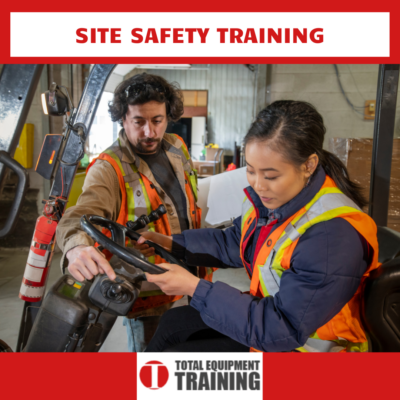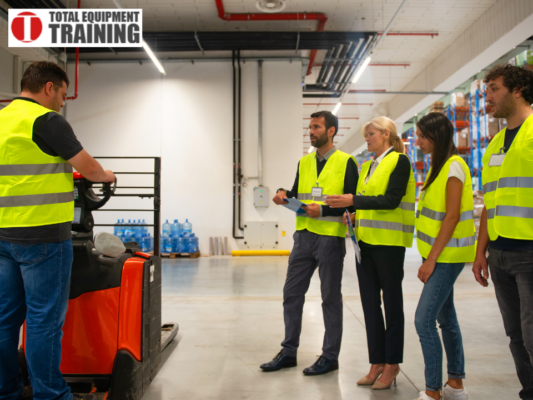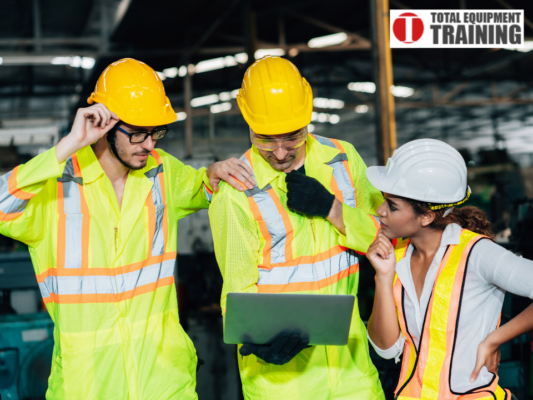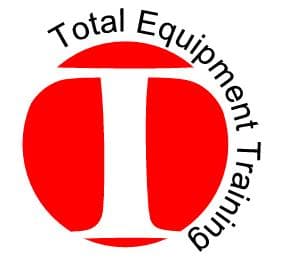
The construction, mining and heavy industries bring man and machine together to create amazing structures, modify the environment to suit our needs, and extract valuable resources that push technology and development on global scales. Like any other place of work, these industries are prone to accidents. The difference is the significance of the effects these accidents have. A miscalculation by a new employee in a business firm may affect the company’s bottom line for the month, but a miscalibration on a piece of heavy equipment may stall a project for months, or even cause fatal injury.
Job site safety training is the dissemination of information meant to prevent accidents from happening, enable workers to properly respond to hazards and emergencies, as well as equipping them with the ability to recover (preferably quickly) after an incident. OSHA (Occupational Safety and Health Administration) is the nationally recognized authority whose core purpose is to create a safe work site by providing safety guidelines and protocols for the workplace. We will now be taking a deeper look at what we can do as employers, employees, and workers to improve and maintain job site safety.
Schedule Job Site Safety Training
What Are the Types of Job Site Hazards?
The number of risks and potential hazards that can cause harm in varying degrees is quite extensive. Here are a few that should be taken into serious consideration:
- Fall Hazards: This is the potential to fall while working at a height (6 feet or more) above the ground. The harm from fall hazards can range from minor (such as sprains) to fatal.
- Struck-by Hazards: Several utilities, such as cranes, lift loads and move them between points on the site. Careless or unaware workers can fatally get struck by travelling loads.
- Electrocution Hazards: This is posed when uninsulated surfaces make contact with live current. In most cases, this hazard is posed by contact with overhead electrical lines. Not only can this damage machinery by overloading circuits, but also prove fatal.
- Pinch Point Hazards: This is where it is possible for a body part to get caught between two surfaces, where at least one is moving. This may result in dismemberment, organ damage by exertion of pressure, suffocation, and even fatality.
- Chemical Hazards: This hazard is posed to workers exposed to harmful/toxic substances, whether in gaseous, liquid, or solid form. Toxicity ranges in intensity, from posing the threat of instant death, to taking years to manifest symptoms.
- Psychological Hazards: Working in dynamic, high risk-high demand environments of the construction and heavy industries can take its toll on any worker, and could negatively affect their mental health. This can lead to depression, and in extreme cases, suicide.
The experienced trainers at Total Equipment Training will come to your work site and perform safety training onsite. Schedule today or give our office a call at (610) 321-2679.
Most Common Causes of Accidents at Construction Sites
Unsafe Actions
An unsafe action is any activity performed on-site by personnel (knowingly or unknowingly) that is outside safe practice or breaks safety standards, with the potential to cause harm to themselves, co-workers, equipment, the surroundings and/or their employer. Unsafe actions are mostly performed by undertrained/untrained personnel, and workers attempting to save on time and/or effort.
Unsafe Conditions
An unsafe condition is a work environment which directly poses dangerous hazards to any workers in it. Unfavorable weather conditions, unstable footing, collapsible surfaces and hazardous chemical exposure are categorical examples. It should be noted, that OSHA has specific guidelines for work and equipment in hazardous conditions.
Improper Handling of Materials and Objects
Moving and/or lifting loads and material is core to the construction industry, with various equipment types developed to handle different material. The nature of the load to be moved varies greatly, (from debris to precious/fragile components) and is often heavy and voluminous. If not attached (e.g., via rigging) or moved properly, the load, personnel working around them, and the equipment moving them can suffer harm/damage.
Falls
Construction often involves working at height, which automatically introduces a fall hazard to personnel. OSHA requires that fall protection equipment (e.g., harnesses, safety belts) be provided for all work done at elevations greater than 4 feet (approx. 1.21 meters). Should a fall occur without the employee equipped with fall PPE, liability falls on the employer.
Machinery Accidents
Every equipment manufacturer includes specific manuals for the proper use of their utilities. Ignoring or skipping proper operational protocols from the manufacturer, overlooking inspection and maintenance, as well as not applying essential training skills can result in equipment damage and personnel harm.
Electrocution
Power cables span across most urban construction sites. Whether overhead or underground, exposure to the current they carry poses a hazard to both personnel and modern equipment –which contain digital components. Some equipment itself can pose the electrocution hazard, due to the large current generated from (engines) and/or for (batteries) its operation.
Repetitive Motion Injuries/Repetitive Strain Injury
This can be interpreted as a long-term accident, in that personnel do not take enough time to rest from repeated exertion of body parts they use frequently at the site. This winds up (unintentionally) wearing out muscle sets and body parts more in comparison to those less-used.
Scaffolding
These temporary, external structures outside buildings in construction are intended to provide safe and easy access of material and personnel to the structure. At the same time, they present a number of hazards to personnel using them, and even the building itself. Being at height, materials and workers on them can slip and fall, and if not erected properly (well-grounded, wind resistant), can collapse and cause harm and damage.

Top Heavy Equipment Accidents
Lack of Fall Protection
In 2016, 384 out of 991 total deaths in construction occurred from workers falling and is considered one of the most common causes of serious work-related injuries and deaths. OSHA requires that fall protection is provided at elevations above four feet in general industry workplaces, six feet in the construction industry and eight feet in the longshoring operations.
It is an employer’s responsibility to prevent workers from falling and to help prevent employees from being injured due to falls. Employers must:
- Guard every floor hole into which a worker can accidentally walk into (using a railing and toeboard or a floor hole cover).
- Provide a guardrail and toe-board around every elevated open sided platform, floor or runway.
- Regardless of height, if a worker can fall into or onto dangerous machines or equipment (such as onto a conveyor belt) employers must provide guardrails and toe-boards to prevent workers from falling and getting injured.
- Other means of fall protection that may be required on certain jobs include safety harness and line, safety nets, stair railings, and handrails.
Schedule Fall Protection Training
Struck by Objects
The most common time to be struck by a crane load is during loading or unloading or caused during flagging, directing or guiding. Struck-by hazards are categorized into four categories: Flying Object, Falling Object, Swinging Object, and Rolling Object.
To avoid these types of job site hazards, be sure to look for the following signs:
- Heavy equipment traffic
- Working backup alarms
- Poor visibility
- Cranes with swing radius clearly marked
- Spotters during backing up
Learn about more causes of crane accidents
Power Line Electrocutions
A crane can be a dangerous piece of equipment if not operated properly, especially when integrating outside variables such as electricity. Electrocution can happen from a variety of elements that your team should be aware of such as, foot touching/guiding loads cables, operating crane and foot touching crane that can result in shock, electrocution, fires, and explosions.
To prevent or eliminate this risk an employer can include the use of:
- Insulation
- Guarding
- Grounding
- Electrical Protective Devices
- Safe Work Practices, such as….
- Avoid working in wet working conditions
- Avoid overhead powerlines
- Use proper wiring and connectors
- Use and maintain tools properly
- Wear correct PPE to control electrical hazards
Remember to always use a certified signal person to assist with your mobile crane operations. Total Equipment Training will come to your work site to perform heavy equipment training so please contact us today!
Why Is Job Site Safety Important?
Job site safety is crucial for the safe operation of any and all work sites. It helps protect employees from causing and experiencing harm to themselves and those around them. Implements and machines (which tend to be expensive) used on-site will also be used properly, extending their operational duration. Several safety protocols have also been made into law, and can lead to costly lawsuits if ignored or circumvented.
OSHA Safety Tips for Job Sites
Improving safety at work sites is actually much easier than perceived, as it can start with a few small steps with lasting impacts:
- Be aware of activities and potential hazards in the work zone
- Inspect all tools and machinery before use
- Always wear proper equipment (protective and functional)
- Keep pathways, entries, and exits clear of obstructions
- Use tools and machines properly
- Follow instructions and manuals
- Communicate hazards as soon as they are identified
Benefits of Job Site Safety Training
Having workers skilled in job site safety training will not only improve the safety of the work site, but also improve the credibility of individual workers and the entire crew; helpful when seeking other work opportunities. Work efficiency also goes up as less time is taken to tend to accidents.
There is also the potential to save on medical expenses and lawsuits, as fewer employees are harmed as they work. Safe work environments reduce psychological stress, leading to better employee retention as a result of job satisfaction.

How to Pass the OSHA Job Site Safety Inspection
OSHA periodically carries out inspections of job sites to assess their safety levels, or if a complaint has been launched. This inspection is made up of 3 parts:
- Opening Conference: The inspector meets worksite representatives and explains their purpose and scope (e.g., employee interviews)
- Facility Walk-Through: A guided tour and actual inspection of the work site, utilities, and safety assessment.
- Closing Conference: Inspector shares findings with representatives and changes to be made.
Some recommendations to pass the inspection include:
- Don’t avoid questions. Withholding information can lead to future repercussions, so it is best to be calm, honest, and direct with the inspector
- Maintain and avail records. Any and all official documentation from employee records to manufacturer communications should be at hand.
- Provide training to all site workers and keep records detailing training.
- Address issues promptly. Any citations or issues raised should be tended to as soon as possible.
Interested in site supervisor training to help pass OSHA safety inspections? Total Equipment Training can assist. Email us with your needs.
How To Avoid Job Site Accidents
There are more ways to avoid accidents than there are the factors that cause them; most being hazard-specific (e.g., maintaining minimum safe distances from overhead cables) with several that cut across the board (e.g., wearing appropriate PPE). Among the most effective measures to avoid accidents is to carry out safety training for staff at all levels. Proper training equips all personnel with the capacity to not only spot and avoid hazards, but accurately approximate the effects of their actions.
Equipment Training
Total Equipment Training is a nationally recognized, OSHA-compliant training and inspection organization equipped with the expertise and experience to properly train, –and retrain- equipment professionals and operators at all levels. Examples of some extensive, quality-oriented heavy equipment programs include:
- Mobile Crane Operator Training
- Forklift Operator Training
- Excavator Operator Training
From these, you and/your team will learn and experience first-hand on best practices and safety procedures that will minimize accidents, especially those from machine accidents and unsafe action.
Service Training
This refers to training received on activities on the work site, but not exclusively focused on heavy equipment. Total Equipment Training has a wide range of both training programs and direct services to choose from for projects of any scale. Some training programs include:
- PPE Training
- Fall Protection Training
- Confined Space Training
- Scaffolding (Assembly, Disassembly and Safety) Training
Essential Training and Beyond
Direct services go beyond essential training, and involve an industry expert/s who visit your work premises and deliver specific services that will facilitate efficiency on site. Such services include:
- Site Supervisors
- Signal Persons
- Heavy Equipment Inspection Services
Do not let yourself or your team become another statistic of avoidable construction site accidents. Reach out to TET today and engage with their friendly front desk in a consultation and hear what their professionals can do for you.
Get Workplace Safety Training
Total Equipment Training is your best partner to ensure you are meeting industry standards for occupational site safety. TET is a nationally recognized, OSHA-compliant organization that trains individuals and groups on a variety of heavy equipment, riggers, and signal persons, and site-specific safety, all thanks to their competent and experienced team. Reach out today to turn your job site into a safer and more efficient workspace.

